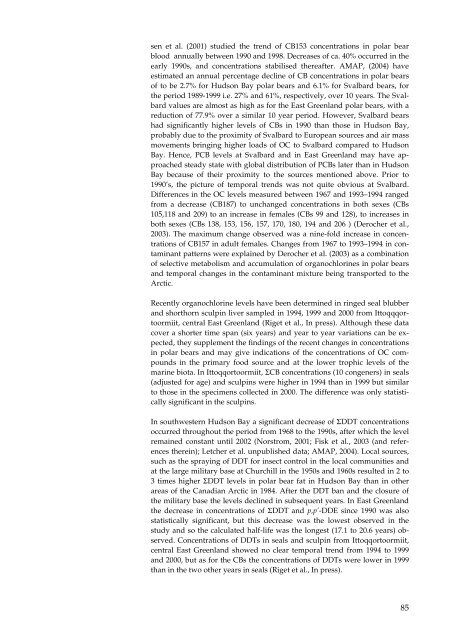Organohalogen concentrations and a gross and histologic ...
Organohalogen concentrations and a gross and histologic ...
Organohalogen concentrations and a gross and histologic ...
Create successful ePaper yourself
Turn your PDF publications into a flip-book with our unique Google optimized e-Paper software.
sen et al. (2001) studied the trend of CB153 <strong>concentrations</strong> in polar bear<br />
blood annually between 1990 <strong>and</strong> 1998. Decreases of ca. 40% occurred in the<br />
early 1990s, <strong>and</strong> <strong>concentrations</strong> stabilised thereafter. AMAP, (2004) have<br />
estimated an annual percentage decline of CB <strong>concentrations</strong> in polar bears<br />
of to be 2.7% for Hudson Bay polar bears <strong>and</strong> 6.1% for Svalbard bears, for<br />
the period 1989-1999 i.e. 27% <strong>and</strong> 61%, respectively, over 10 years. The Svalbard<br />
values are almost as high as for the East Greenl<strong>and</strong> polar bears, with a<br />
reduction of 77.9% over a similar 10 year period. However, Svalbard bears<br />
had significantly higher levels of CBs in 1990 than those in Hudson Bay,<br />
probably due to the proximity of Svalbard to European sources <strong>and</strong> air mass<br />
movements bringing higher loads of OC to Svalbard compared to Hudson<br />
Bay. Hence, PCB levels at Svalbard <strong>and</strong> in East Greenl<strong>and</strong> may have approached<br />
steady state with global distribution of PCBs later than in Hudson<br />
Bay because of their proximity to the sources mentioned above. Prior to<br />
1990’s, the picture of temporal trends was not quite obvious at Svalbard.<br />
Differences in the OC levels measured between 1967 <strong>and</strong> 1993–1994 ranged<br />
from a decrease (CB187) to unchanged <strong>concentrations</strong> in both sexes (CBs<br />
105,118 <strong>and</strong> 209) to an increase in females (CBs 99 <strong>and</strong> 128), to increases in<br />
both sexes (CBs 138, 153, 156, 157, 170, 180, 194 <strong>and</strong> 206 ) (Derocher et al.,<br />
2003). The maximum change observed was a nine-fold increase in <strong>concentrations</strong><br />
of CB157 in adult females. Changes from 1967 to 1993–1994 in contaminant<br />
patterns were explained by Derocher et al. (2003) as a combination<br />
of selective metabolism <strong>and</strong> accumulation of organochlorines in polar bears<br />
<strong>and</strong> temporal changes in the contaminant mixture being transported to the<br />
Arctic.<br />
Recently organochlorine levels have been determined in ringed seal blubber<br />
<strong>and</strong> shorthorn sculpin liver sampled in 1994, 1999 <strong>and</strong> 2000 from Ittoqqqortoormiit,<br />
central East Greenl<strong>and</strong> (Riget et al., In press). Although these data<br />
cover a shorter time span (six years) <strong>and</strong> year to year variations can be expected,<br />
they supplement the findings of the recent changes in <strong>concentrations</strong><br />
in polar bears <strong>and</strong> may give indications of the <strong>concentrations</strong> of OC compounds<br />
in the primary food source <strong>and</strong> at the lower trophic levels of the<br />
marine biota. In Ittoqqortoormiit, ΣCB <strong>concentrations</strong> (10 congeners) in seals<br />
(adjusted for age) <strong>and</strong> sculpins were higher in 1994 than in 1999 but similar<br />
to those in the specimens collected in 2000. The difference was only statistically<br />
significant in the sculpins.<br />
In southwestern Hudson Bay a significant decrease of ΣDDT <strong>concentrations</strong><br />
occurred throughout the period from 1968 to the 1990s, after which the level<br />
remained constant until 2002 (Norstrom, 2001; Fisk et al., 2003 (<strong>and</strong> references<br />
therein); Letcher et al. unpublished data; AMAP, 2004). Local sources,<br />
such as the spraying of DDT for insect control in the local communities <strong>and</strong><br />
at the large military base at Churchill in the 1950s <strong>and</strong> 1960s resulted in 2 to<br />
3 times higher ΣDDT levels in polar bear fat in Hudson Bay than in other<br />
areas of the Canadian Arctic in 1984. After the DDT ban <strong>and</strong> the closure of<br />
the military base the levels declined in subsequent years. In East Greenl<strong>and</strong><br />
the decrease in <strong>concentrations</strong> of ΣDDT <strong>and</strong> p,p’-DDE since 1990 was also<br />
statistically significant, but this decrease was the lowest observed in the<br />
study <strong>and</strong> so the calculated half-life was the longest (17.1 to 20.6 years) observed.<br />
Concentrations of DDTs in seals <strong>and</strong> sculpin from Ittoqqortoormiit,<br />
central East Greenl<strong>and</strong> showed no clear temporal trend from 1994 to 1999<br />
<strong>and</strong> 2000, but as for the CBs the <strong>concentrations</strong> of DDTs were lower in 1999<br />
than in the two other years in seals (Riget et al., In press).<br />
85

















